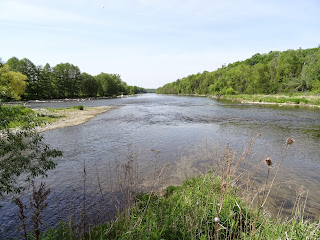Alyssa and I packed a lunch, donned chest waders, forded the Grand and spent a couple of hours searching the island. As this post title suggests, we didn't have any luck. That's not to say that it no longer occurs on the island, but in a spot subject to seasonal inundation, ice scour and, as it turns out, a tonne of Garlic Mustard, Bouncing Bet and a couple of well-fed deer, I don't have much hope that it's still there.
Break [need to dispose of this dog tick crawling up my leg]
Crossing the river, gonna put my brand new butterfly net to work.
A nice view southward toward Glen Morris from the southern tip of the island. A couple of Spotted Sandpiper were foraging on the island spit to the left, Warbling Vireo, Chestnut-sided Warbler and Baltimore Oriole provided the soundtrack for the morning.
The open areas were dominated by Bouncing Bet, Late Goldenrod and American Stinging Nettle.
Beneath a canopy of Sycamore, mostly Garlic Mustard and more nettle.
This area, probably totaling 0.1ha in size, seemed to me the most likely place for Wild Licorice, I spent a good while here looking for the vetch-like, deep green leaves or the bur-like seed heads from last year, but came up empty-handed. Assuming the topography/form of the island hasn't changed too much since 1902, I would hazard a guess that the licorice would have occurred in this high-and-dry opening.
Oh well, it was worth a shot.
There were a few locally interesting species including Moonseed (Menispermum canadense). A vine with bluntly lobed leaves; you can often find this along rivers or in wet thickets.
Tonnes of Ostrich Fern (Matteuccia struthiopteris).
Carpenter's Square (Scrophularia marilandica) grows in among the Sycamore, the second photo shows the 90 degree square stems which give the plant it's common name.
White Snakeroot (Ageratina altissima). Which always brings this song to mind.
Silvery Cinquefoil (Potentilla argentea) grows along the active banks of the island and thrives on disturbed soils.
A couple of isolated pools were chock full of tadpoles.
I bought a few glass vials with my butterfly net; as it turns out the glare on glass makes for crap photos so here I try to lure the duskywing out and back into the net.
Based on my resources I'm going with Juvenal's Duskywing but if anyone thinks otherwise feel free to leave a comment. I'm new to this.Alyssa and I headed down to Paris for an ice cream cone at Chocolate Sensations then hiked another trail for a couple of hours. This trail follows the last couple of kilometers of the Nith River before it meets the Grand. When we finally got to the good stuff, rich deciduous forest slopes, bluffs, and limestone flats, it was looking like rain and we were starting to feel a bit tired. For another time.
















Yup looks to be a worn Juvenal's Duskywing. That inside spot closest to the body on the forewing is usually diagnostic.
ReplyDeleteHey There. I found your blog using msn. This is a very well written article. I’ll be sure to bookmark it and come back to read more of your useful info. Thanks for the post. I’ll definitely return. Wood Dice
ReplyDelete